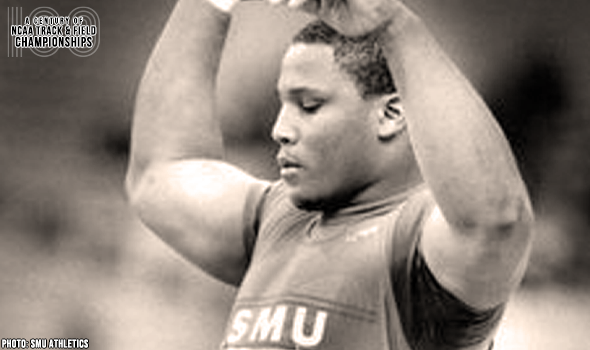
Carter’s Shot Put Prowess Was Legendary
In January 1983, Michael Carter of SMU picked up a shot for the first time in 18 months.
By June of that same year, he was looking to regain the national title in that event at the NCAA Division I Outdoor Track & Field Championships in Houston.
Carter – who had won in 1980 and 1981 – wasn’t able to try for a third in 1982 when he missed the entire indoor and outdoor seasons recovering from a football injury he suffered in October 1981. He was the starting nose tackle for the Mustangs, who were undefeated in 1982 and only lost one game in 1981.
After the cast on Carter’s right knee came off in January 1982, Carter showed his competitive side, telling John Eisenberg of the Dallas Times-Herald: “As soon as I get the go-ahead, I’m going to bust my butt like I never did before. I’m going to make my legs stronger than they ever have been.”
Meanwhile, another strong throwing figure emerged in 1982 with Carter’s absence – Oregon’s Dean Crouser, who not only won the NCAA shot that year but the discus as well. And the day before the 1983 NCAA shot final, Crouser looked great, repeating his discus win with a meet-record 65.88m (216-2) while Carter was 10th (Carter placed runner-up two years earlier in 1981).
Carter made this shot final his from the beginning. He took the immediate lead with a 20.22m (66-4¼) effort in Round 1 and then followed with the winning have of 20.90m (68-7) – his best since a pre-injury 21.25m (69-8¾) that set an NCAA Indoor meet record in 1981. Crouser, the defending champion, finished third behind John Brenner of UCLA.
As it turns out, Carter’s points were crucial to SMU, which eked out a two-point victory over Tennessee to complete a sweep of indoor and outdoor team crowns.
“I knew in the back of my mind that Crouser could hit a big one at any time,” Carter said after the meet. “I tried to improve after the second throw, but I couldn’t. I wanted to keep my string alive; my goal is eight straight.”
At this point, Carter had six national titles in the shot put – three each indoor and outdoor. He got to seven with his indoor victory in 1984, but his attempt for eight was part of an epic duel with Brenner that will be the subject of its own forthcoming moment in this series.
Alas for track & field fans, Carter’s last shot put competition came when he earned the silver medal at the Los Angeles Olympics. He then joined the NFL’s San Francisco 49ers, with whom he was part of three Super Bowl champion teams.
Michael’s two daughters also won NCAA titles – Michelle (Texas), the 2006 indoor shot put champion; D’Andra (Texas Tech), the 2009 discus champion – making the Carters the first family with three NCAA Division I track & field champions. In 2016, Michelle earned the family’s first Olympic gold medal, also becoming the first American woman to win the shot put.
The NCAA and collegiate track & field will mark a momentous milestone in the spring of 2021 -- the 100th anniversary of the NCAA Championships and with that, the NCAA Track & Field Championships. In June 1921, the University of Chicago hosted the first track & field championships in NCAA history.
This point can’t be emphasized enough: Not only was the event the first for NCAA track & field, but the first championships for any sport under the sponsorship of the NCAA.
To celebrate, over each of the next 365 days, the U.S. Track & Field and Cross Country Coaches Association (USTFCCCA) will celebrate moments, student-athletes, and coaches that have made a century’s worth of championships special. From humble beginnings to important historical milestones to the modern-day, collegiate track & field has evolved with the American society.
The 2021 edition of the NCAA Division I Outdoor Track & Field Championships begin with preliminary round action on May 27-29 in Jacksonville, Fla., and College Station, Texas. The championships final site and culmination of the celebration is slated for June 9-12, 2021 at the newly rebuilt Hayward Field in Eugene, Ore.
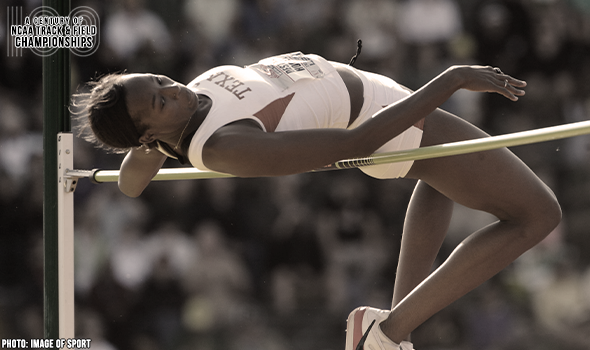
Texas’ Hooker High Jumped To NCAA Glory
Destinee Hooker won three career high jump titles at the NCAA DI Outdoor T&F Championships, including a massive victory in 2009 by more than two inches.
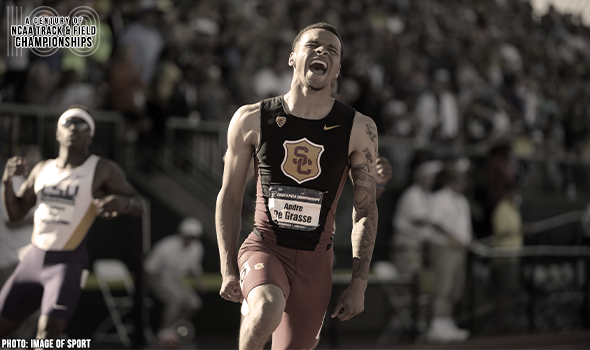
De Grasse Sprinted To Otherworldly Double
Andre De Grasse completed the 100-200 double at the 2015 NCAA DI Outdoor T&F Championships with scorching times: 9.75 (+2.7) in the 100; 19.58 (+2.4) in the 200.
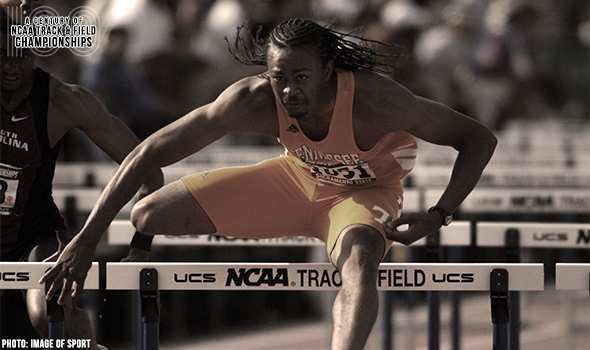
Merritt Broke Long-Standing 110H MR In 2006
Aries Merritt broke a 28-year-old meet record in the 110H when he won the crown at the 2006 NCAA DI Outdoor T&F Championships in 13.21.
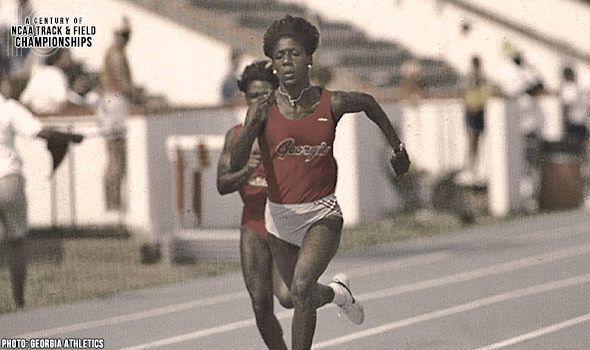
UGA’s Torrence Made NCAA History With Double
Gwen Torrence completed the 100-200 double at the 1987 NCAA DI Outdoor T&F Championships. Torrence was also the first woman to finish top-8 four times in the 100.
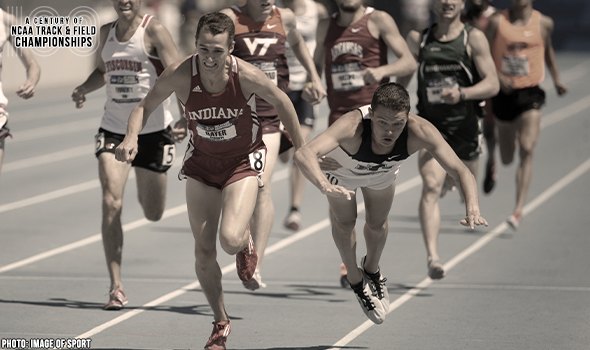
Bayer Gave It His All For NCAA 1500 Title
Andrew Bayer won the 1500 at the 2012 NCAA DI Outdoor Track & Field Championships in one of the closest finishes in meet history – 0.01 seconds.

Tipton Led 1-2-3 Oregon Finish In 1964 JT
Les Tipton led the first podium sweep of any event in the history of the NCAA Outdoor T&F Championships. Tipton and his Oregon teammates went 1-2-3 in the 1964 javelin.

K-State’s Jones Captured Heptathlon Crown In 2015
Akela Jones won the heptathlon at the 2015 NCAA DI Outdoor T&F Championships with 6371 points. That is the fourth-best score in both collegiate history & meet history.

Same Athletes, Same Result For LSU At NCAAs
The LSU foursome of Bennie Brazell, Pete Coley, Robert Parham, Kelly Willie swept the 4×100 & 4×400 crowns at the 2003 NCAA DI Outdoor T&F Championships.

Martin Won Distance Titles For Two Programs
Francis (Frank) Martin made history twice in the NCAA Outdoor Track & Field Championships.

FSU’s Williams Soared To Jumps Double In 2009
Kim Williams swept the horizontal jumps at the 2009 NCAA DI Outdoor T&F Championships. Williams was particularly dominant in the TJ, winning at 14.38m (47-2¼) & by nearly 2 feet.

